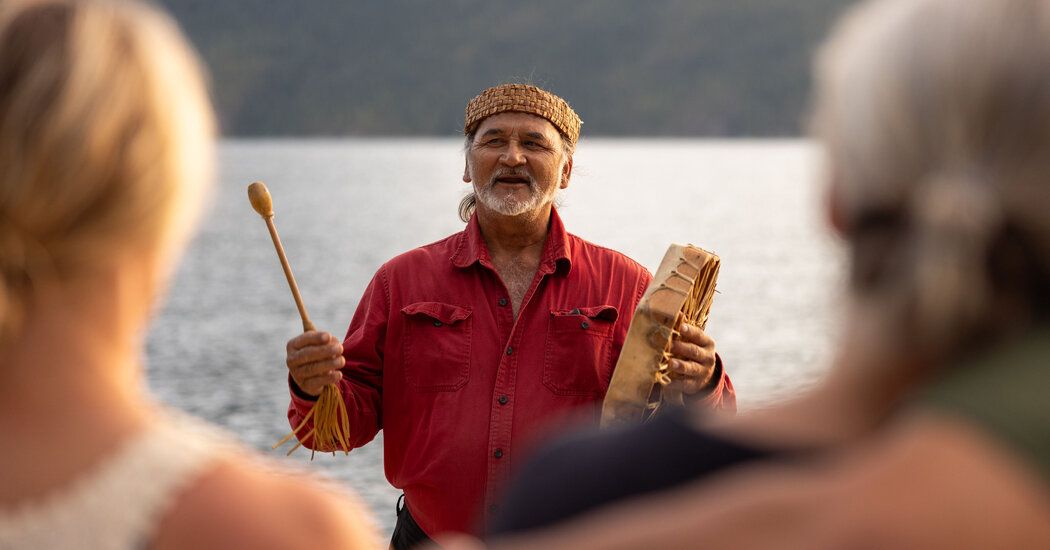For visitors to New Zealand, the chance to see a haka, the Maori ceremonial dance, has long been as attractive a part of the country as its glaciers, geysers and glow-worm caves.
But increasingly, rather than simply taking in a cultural spectacle on the way to New Zealand's Fiordland, travelers are staying longer and digging deeper, seeking more immersive ways to interact with the country's indigenous heritage.
“We're seeing a shift from a box-ticking mentality to a hunger for deep, transformative experiences,” said Sarah Handley, managing director for North America and Europe at Tourism New Zealand, the country's tourism marketing agency. “It's not just about witnessing a haka; it’s about understanding the meaning and the stories behind it.”
That shift is happening not just in New Zealand but around the world, particularly as more travelers want to experience the planet's natural wonders through the people and traditions indigenous to those places.
“Simply put, travelers want to get more out of their vacation,” said Jamie Sweeting, vice president of sustainability at tour company G Adventures, whose itineraries include overnight accommodations ranging from an indigenous-owned ecolodge in the Ecuadorian Amazon even a community. Homestay with the Tengger tribe of Indonesia. Especially since the pandemic, Sweeting said, people are looking for “experiences that help them change the way they see the world.” Indigenous-owned and led tourism experiences – a sector of the global tourism market valued at $40 billion in 2022 and projected to grow to $65 billion by 2032 – are increasingly the answer.
Embracing slow travel, the Maori way
In New Zealand's North Island, visitors eager for culturally immersive nature experiences are spoiled for choice.
In the Bay of Plenty region, which has a long tradition of Māori-led nature tourism, Māori-owned Te Urewera Treks offers single and multi-day guided nature walks through the Te Urewera Rainforest, the first in the world to receive the status of a legal entity. (meaning the forest is now effectively its own owner) in recognition of the traditional Maori worldview. (Guided one-day walks start at NZ$240, or about $151; a three-day walk costs $1,050, with nights camping or in New Zealand's famous country cabins.)
About an hour's drive north, Kohutapu Lodge (double rooms from $100) offers an equally immersive alternative to some of the Maori cultural experiences available in nearby Rotorua, whose Maori dinner and show nights have helped keep it within reach. the height of your expectations. Nickname RotoVegas. Instead, Kohutapu encourages guests to take slow journeys, Maori style, with an extensive menu of cultural, culinary and nature-based activities that highlight both the region's indigenous history and contemporary Maori life.
“We invite our visitors into our community, our home, our way of life, and it's very natural,” said Kohutapu Lodge co-owner Nadine Toe Toe. Travelers “are looking for more authentic and intimate experiences, outside the main centers, that are based on real life.”
“The pandemic absolutely pushed our visitors into a new way of thinking about travel,” he said.
Jerry Whalen, 72, visited New Zealand with his wife, Cyndi, on a Viking ocean cruise in December 2022. Opting for a North Island land excursion with a Maori cultural focus, the couple spent a full afternoon at Kohutapu Lodge which included a guided walk to see ancient Maori rock paintings, a traditional meal cooked on hot stones and an intimate haka demonstration. The Whalens were so enthralled with Kohutapu that they have kept in touch with Mrs. Toe Toe and hope to return for a longer stay.
In Australia, large companies join
Across the Tasman Sea, Australia is also seeing a surge in demand for Indigenous-led travel. Mark Olsen, chief executive of Tourism Tropical North Queensland (the majority Indigenous region that includes the Great Barrier Reef), has seen an increase in both the number of domestic travelers engaging in Indigenous experiences and the average number of nights they spend doing it. Tourism Australia, the Australian government's tourism marketing agency, has recorded a similar trend among international visitors over the past decade.
The intersection between tourism and Australia's indigenous peoples, Aboriginal and Torres Strait Islander people, has not always been so promising. In 2017, Australia made international headlines when it banned people from ascending Uluru, the iconic monolith in Australia's Red Center that is also one of the country's most visited tourist attractions. But the ban came only after decades of pleas from the local Aboriginal community not to climb the site, which is sacred to them.
However, today, in addition to a growing number of Indigenous-owned and operated tour businesses in Australia, Olsen noted that even large tour companies are making efforts to “involve traditional owners in their tours.” Operations like Dreamtime Dive & Snorkel, “which employs indigenous guides who share their culture and stories during the trip to the Great Barrier Reef” (day trips from $219 Australian dollars, or about $150), refute the idea that Australia's natural sites and Aboriginal culture should be experienced separately.
A global trend
These advances in the travel industry reflect a broader social trend. “Globally, there has been a push to recognize indigenous rights and more and more attempts are being made to correct past mistakes,” said Julia Albrecht, associate professor in the Department of Tourism at the University of Otago in New Zealand.
“In New Zealand,” Dr Albrecht noted, “the last two governments have been hugely supportive of all things Māori, not just in narrative but also in policy.” In November, Tourism Industry Aotearoa, the main association representing the country's tourism businesses, published its Tourism 2050 strategy, which calls for “integrating kaupapa Maori (Māori approach) and matauranga Maori (Māori knowledge) into the tourism industry”.
These initiatives, along with the creation of indigenous networks such as the Global Indigenous Tourism Alliance and vastly improved visibility through mainstream marketing and social media, have created “a case of supply and demand complementing each other,” Anna said. Carr, associate professor and colleague of Albrecht at the University of Otago.
Like G Adventures, tour operator Intrepid Travel is expanding its indigenous tourism portfolio, introducing new indigenous experiences in the United States, Australia, Taiwan, Canada, Nicaragua and Costa Rica in 2024. One constant, said Sara King, general manager of Purpose at Intrepid, there have been “particularly emotional” comments from customers.
Erin Rowan, 32, from Boulder, Colorado, chose British Columbia's Klahoose Wilderness Resort, owned by the Klahoose First Nation, for her honeymoon last September. In Canada's remote Desolation Sound, the resort offers “all-inclusive wildlife and cultural tours,” including indigenous-led grizzly bear viewing during the annual salmon run (three- and four-night all-inclusive stays from of 2,495 Canadian dollars, or about $1,824, plus taxes and fees).
Ms. Rowan and her husband, Matt Allegretto, wanted a trip “that seemed intentional and in line with our values,” and after finding Klahoose Wilderness Resort “on TikTok, of all places,” Ms. Rowan said, “ “a light bulb went off.”
“We feel welcomed into a world that is completely different from our everyday lives,” Rowan said, adding that she and her husband hope to make Indigenous-led experiences “an important thread in our future travels.”
Follow the travels of the New York Times in instagram and Subscribe to our weekly Travel Dispatch newsletter for expert tips on how to travel smarter and inspiration for your next vacation. Are you dreaming of a future getaway or simply traveling from an armchair? 52 places to go in 2024.








